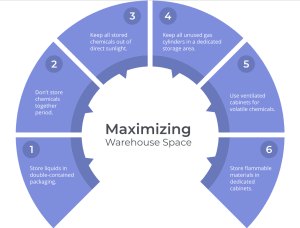How Has Inventory Tracking Changed Modern Warehousing?

Inventory tracking has changed everything about warehousing, allowing companies to efficiently store and locate their inventory. But how exactly has this happened? Below we take a look at how exactly inventory tracking has changed modern warehousing and what it means for the future of business and supply chain management.
What Is Inventory Management?
Inventory management is an important step in a warehouse’s process, from taking delivery of products to processing outgoing shipments. A system for inventory tracking can help warehouses maximize their efficiency. And productivity while also keeping their costs down by reducing waste. Most modern warehouses will always want to include an inventory management system as part of their warehouse software. And that is why it’s important to familiarize yourself with how these systems work if you’re in charge of your company’s warehousing operations.
Benefits of WMS for Small Businesses
Two of the most important benefits of WMS are improved inventory tracking and real-time management. Small businesses usually don’t have an IT team to help with inventory tracking. So they need software that makes it easy for them to track their stock levels. A WMS can automate stock levels and also identify any issues quickly. For example, if something is running low or if you’re about to run out, a WMS will automatically make a new order for you. This reduces time spent on inventory tracking as well as wasted stock. Being able to view your stock levels in real time means you always know what level your warehouse is at, which means there are no surprises come delivery day.
Thanks to modern technology, WMS systems today are much cheaper than ever before. They’re also more versatile and scalable—meaning once your small business grows, you won’t need to change software again. And remember: The sooner you implement a WMS, the more money and headaches it will save down the line!
What about product options? One of the best features of WMS software is the amount of available product options. This feature allows you to customize products for each customer, and even for each individual order. Imagine not being able to sell a shirt in different sizes, colors, and fabrics to different customers! If you’re selling clothes or other items with variations (like size or color), then implementing a WMS that offers product options could help your business grow exponentially.
Maximizing Warehouse Space

The Importance of Warehouse Management Software
Warehouse management software (WMS) is a powerful tool for modern warehousing. WMS solutions increase operational efficiency by automating various warehouse tasks. And allowing companies to track inventory more accurately and freeing up their employees from repetitive and manual processes.
So, if you’re left wondering how exactly has inventory tracking changed modern warehousing – here are four ways it’s impacted every aspect of business
- Real-time visibility into stock levels keeps everyone informed in real-time.
- Improved accuracy means you know where your shipments are at all times—no more costly recalls or returns due to inaccurate records.
- Reduced labor costs save you money—employees can focus on higher-level tasks without having to waste time counting or inputting data manually!
- Save time with integrated shipping labels.
Tips for Selecting the Right Warehouse Management System (WMS)
WMS is a computer-based system that allows businesses to keep track of inventories, shipments, and supplies. Companies that handle large volumes of stock use WMS systems to ensure they don’t run out of inventory or accidentally ship twice. In some cases, warehouse managers may choose to implement a new version of an existing software system; in other instances, they’ll look for something entirely new. Either way, it’s important for companies to weigh their options carefully when selecting a WMS.
- Determine your needs before shopping around for solutions: First and foremost, you should evaluate how you plan to use your WMS before looking at any specific products. It might be tempting to fall in love with flashy features (like analytics capabilities), but you should first determine what kind of functionality your business truly needs. For example, if you want an app so customers can scan barcodes on their phones to learn more about each product—that shouldn’t take priority over shipping orders within 24 hours.
- Look beyond cost: The initial price tag is only one part of choosing a solution—and many times, not even the most important factor. You also need to consider factors like setup time, how easily your company can integrate with third-party systems, and training requirements. While it’s easy to get blinded by lower upfront costs, doing so could lead you down a path where your business spends more money later on because technology isn’t working properly.
- Make sure there are updates and support included: While buying a top-notch WMS from a reputable provider does come with its advantages, make sure it comes with free updates in case technology changes quickly.
What Are the Most Popular Types of Warehouse Management Systems in Use Today?
Today you can find a huge range of inventory tracking systems in use. Each system has its own specific purpose and set of features. In general, though, they’re used to track items in a warehouse, ensure they are delivered on time, and that their prices remain competitive. An on-premise WMS gives total control over your inventory – it can’t be tampered with or stolen by any unauthorized users. With an off-site WMS solution, anyone who knows your login credentials could potentially access your data and manipulate it if they had ill intentions.
Is Cloud Computing Causing More Companies to Use WMS Software?: No, cloud computing isn’t causing more companies to use warehouse management systems – it’s just making them more popular than ever before! In fact, there has been a steady increase in demand for such solutions over recent years; experts predict that they will continue rising in popularity over time.
Inventories are changing rapidly. Here’s why.
The times they are a-changin’. As consumers, we’re more aware of what’s in our food and where it comes from than ever before. New technologies are allowing for better visibility into materials management and inventory tracking. But also bringing a new set of challenges along with them. So how is inventory tracking changing modern warehousing? And what does it mean for your business?
It provides real-time visibility into all aspects of material movement. As well as robust analytics regarding performance based on location, time period, and more. Its sleek interface allows employees at every level to easily use its features; even entry-level workers can complete common tasks quickly and easily!
Choosing a Software Solution
There are several products on the market that do inventory management. But they don’t all offer exactly what a warehousing operation needs. You want to choose a solution that covers everything you need and consult an expert if necessary. The last thing you want is to spend money on software only to realize it isn’t helping your business at all. Ask any questions you have upfront. Also, be sure your staff (and especially managers) are trained properly so they can use the system effectively. Chances are everyone involved in receiving inventory should know how to fill out reports and make adjustments or corrections in as efficient a manner as possible so any missing or damaged goods can quickly be discovered and dealt with—ensuring accuracy of quantities received while eliminating costly re-order situations caused by misplaced items.
Implementing an Effective Inventory Control System at Your Company
You can’t manage what you don’t measure. A simple inventory control system is a key component to success for warehousing and logistics professionals. It’s all about knowing where your goods are and keeping them moving. So that customers get what they need when they need it. By consistently using an inventory management solution, warehouses can gain more control over their operations, reduce costs and increase efficiency. An effective warehouse inventory management system will give companies access to real-time information regarding inventories while also improving customer service. Warehouse managers and logisticians can leverage software systems designed to help optimize processes. And making businesses more efficient, flexible, and competitive in today’s dynamic global marketplace. When used correctly these tools will keep the excess product from accumulating in stockrooms or even worse being sent out before orders have been placed!
Final Thoughts
One of today’s most important steps in warehousing is inventory tracking. By implementing new technologies to track inventory throughout every stage of fulfillment. And warehouse managers can accurately account for their inventory levels, as well as order more supplies when needed. Beyond keeping a close eye on stock levels, businesses need to make sure that their inventory tracking software and hardware are up-to-date.





